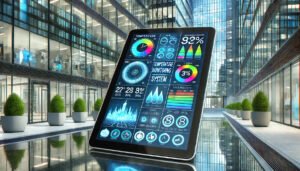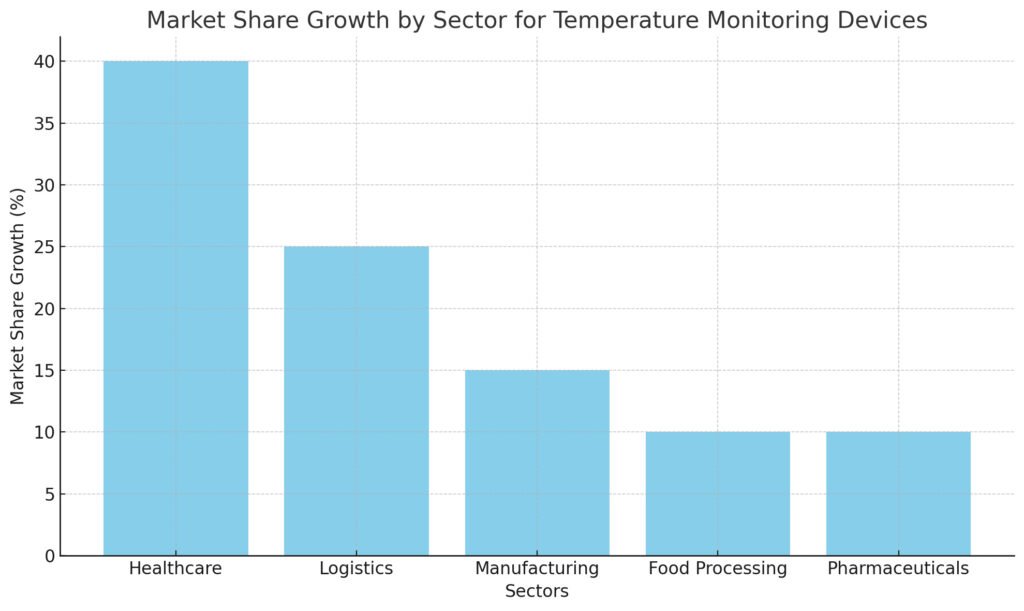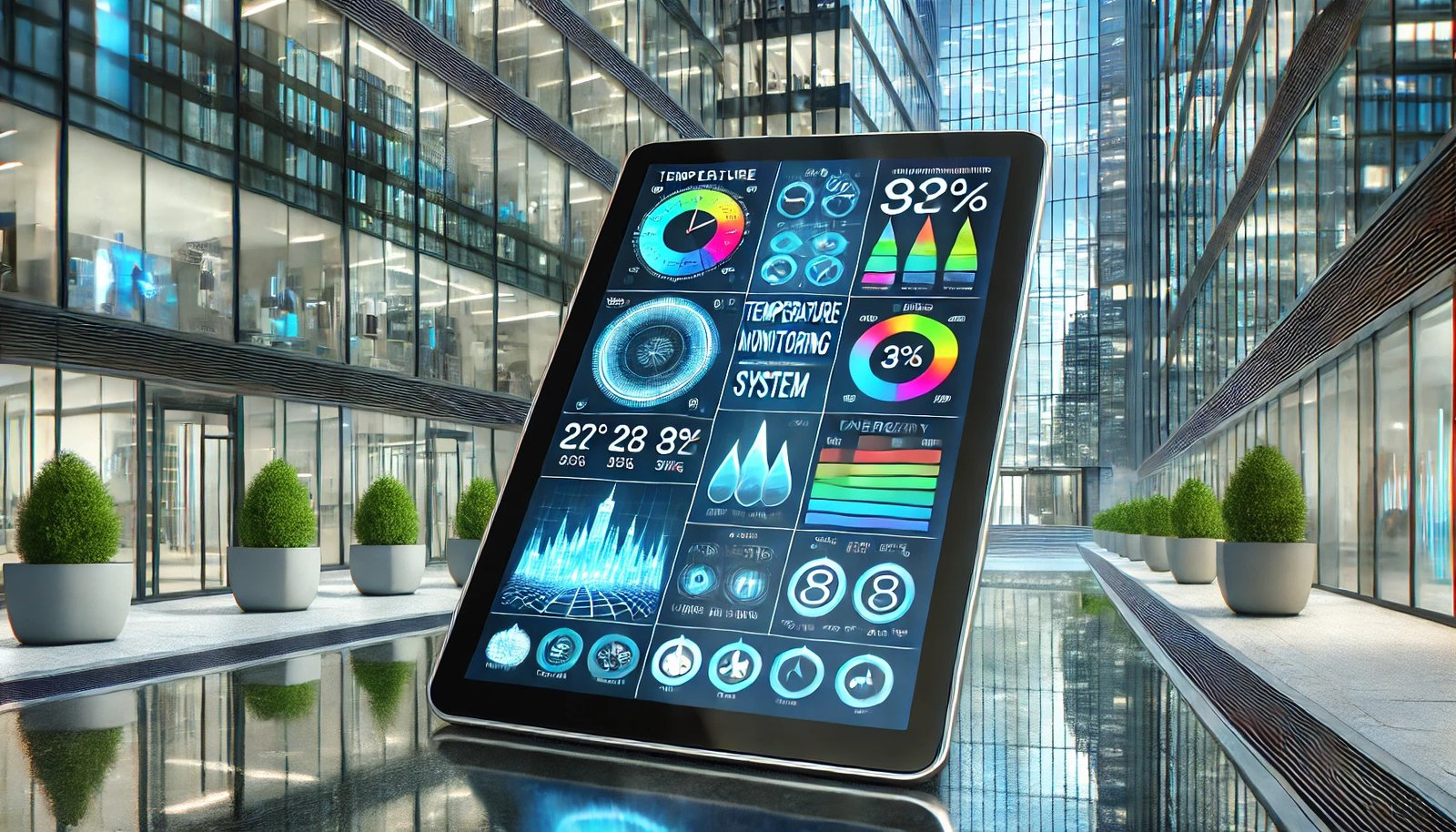Introduction
The temperature monitoring devices market is poised to experience substantial growth, projected to reach a market value of USD 5.3 billion by 2034. With a CAGR of 4.5% from 2024 to 2034, this expansion reflects the rising demand for temperature monitoring technology across various sectors, particularly healthcare, logistics, and manufacturing. The growing emphasis on telehealth, remote patient monitoring, and cold chain logistics presents significant business opportunities for companies in the temperature monitoring device space.
As businesses grapple with the need to maintain product quality, ensure regulatory compliance, and improve operational efficiency, the demand for accurate and reliable temperature monitoring solutions continues to soar. This blog explores the key drivers behind the growth of the temperature monitoring devices market, identifies emerging trends, and outlines potential business opportunities for industry players, investors, and entrepreneurs.

Market Growth Drivers
Increased Demand in Healthcare
The healthcare industry has long been a dominant user of temperature monitoring devices. However, several recent trends have contributed to a surge in demand for these devices, creating a multi-billion-dollar opportunity for businesses involved in healthcare technology.
Telehealth and Remote Patient Monitoring
One of the most significant trends driving the temperature monitoring devices market is the rise of telehealth and remote patient monitoring. With the increasing prevalence of infectious diseases and chronic conditions, healthcare providers have turned to remote monitoring technologies to reduce hospital visits and manage patient care more efficiently. Temperature monitoring devices, in particular, are critical for detecting early signs of infection, fever, or other health issues, making them indispensable in telehealth applications.
- Business Implications: Companies that manufacture or distribute temperature monitoring devices for the healthcare sector are well-positioned to benefit from the growing demand for remote monitoring solutions. Telehealth platforms and healthcare providers are also potential partners, creating opportunities for strategic alliances and product integrations.
Addressing Infectious Disease Management
Infectious diseases like COVID-19, influenza, and other respiratory illnesses have underscored the need for continuous temperature monitoring in healthcare settings. As hospitals and clinics prioritize early detection of febrile conditions, temperature monitoring devices have become essential tools in managing patient care.
- Business Relevance: Device manufacturers that offer innovative, accurate, and easy-to-use solutions stand to gain from the sustained demand in infectious disease management. With governments and healthcare institutions increasingly focused on public health infrastructure, there is room for expansion in the form of bulk procurement contracts and partnerships with healthcare facilities.

Technological Advancements in Temperature Monitoring Devices
Enhancing Device Accuracy and Usability
Technological innovations are playing a pivotal role in the temperature monitoring devices market, enabling manufacturers to produce devices that offer superior accuracy, connectivity, and usability. Devices today are equipped with advanced sensors, improved algorithms, and user-friendly interfaces, making them ideal for both clinical and non-clinical applications.
- Key Innovations:
- Non-invasive monitoring: Developments in non-invasive temperature monitoring devices, such as skin patches and wearable thermometers, have made these tools more appealing in the healthcare industry.
- Wireless connectivity: Devices with Bluetooth and Wi-Fi connectivity enable real-time temperature tracking and remote data sharing, streamlining clinical workflows.
- Business Opportunities: Companies that leverage these innovations can differentiate their products in a competitive market. The ability to offer seamless integration with electronic health record (EHR) systems, cloud-based data storage, and predictive analytics further enhances the appeal of these devices to healthcare providers.
Integration with IoT and AI Technologies
The integration of Internet of Things (IoT) and Artificial Intelligence (AI) technologies has revolutionized the temperature monitoring devices market. IoT-enabled devices allow continuous, real-time temperature tracking across various environments, while AI algorithms can analyze temperature data to detect anomalies, predict trends, and provide actionable insights.
- IoT Use Cases:
- In healthcare, IoT-enabled devices can monitor patients’ temperatures remotely and alert medical staff of any concerning changes.
- In logistics, IoT sensors are used to track the temperature of perishable goods during transportation, ensuring product integrity.
- Business Relevance: The adoption of IoT and AI technologies creates significant business opportunities for temperature monitoring device manufacturers, software developers, and logistics companies. Firms can expand their offerings by developing proprietary IoT platforms or AI-driven analytics solutions tailored to specific industries such as healthcare, pharmaceuticals, and food processing.
Diverse Applications Beyond Healthcare
While healthcare remains a core market for temperature monitoring devices, other industries are increasingly recognizing the value of these technologies. This presents a unique opportunity for businesses to expand their target markets and tap into new revenue streams.
Manufacturing and Industrial Use
Temperature monitoring devices play a crucial role in ensuring the quality and safety of industrial processes, particularly in manufacturing sectors where temperature-sensitive operations are critical. From chemical production to metalworking, maintaining precise temperature control is essential to prevent equipment failure, ensure product quality, and comply with safety regulations.
- Key Industries:
- Pharmaceuticals: Ensuring consistent temperatures during drug production and storage is vital for maintaining product efficacy.
- Food Processing: Temperature monitoring helps prevent spoilage, contamination, and regulatory non-compliance in food production and storage facilities.
- Business Opportunities: The growing emphasis on product quality and safety in manufacturing presents opportunities for B2B partnerships between temperature monitoring device suppliers and industrial companies. Firms that provide customized, robust, and industrial-grade solutions can establish long-term relationships with manufacturers across multiple sectors.
Logistics and Cold Chain Management
The importance of temperature monitoring is particularly evident in logistics and cold chain management. In industries such as pharmaceuticals, food, and agriculture, maintaining the appropriate temperature during transportation and storage is critical for ensuring product integrity and compliance with regulatory standards.
Cold Chain Logistics for Pharmaceuticals and Food
Temperature monitoring devices are essential for the transportation of temperature-sensitive goods such as vaccines, biologics, fresh produce, and frozen foods. The global cold chain logistics market is expected to grow significantly in the coming years, driven by rising demand for vaccines, biologics, and fresh food products.
- Business Implications:
- The growing need for cold chain logistics presents an opportunity for device manufacturers to develop rugged, reliable, and IoT-enabled temperature monitoring solutions specifically designed for transportation environments.
- Companies involved in logistics and supply chain management can differentiate themselves by adopting state-of-the-art temperature monitoring technology, thereby enhancing their service offerings to pharmaceutical and food manufacturers.
Regulatory Compliance and Quality Assurance
Across various industries, regulatory compliance and quality assurance are key concerns. Temperature monitoring devices play a critical role in helping companies adhere to industry standards, such as the Food and Drug Administration (FDA) and European Medicines Agency (EMA) guidelines in the pharmaceutical and food sectors.
- Key Regulations:
- In pharmaceuticals, guidelines such as Good Distribution Practices (GDP) require stringent temperature control during the storage and transport of temperature-sensitive products.
- In food processing, Hazard Analysis and Critical Control Points (HACCP) regulations necessitate continuous temperature monitoring to prevent contamination and ensure food safety.
- Business Opportunities: Device manufacturers that can demonstrate compliance with these regulatory frameworks can capture a larger share of the temperature monitoring devices market. Offering products that are certified for regulatory compliance or providing integrated data logging and reporting features will be highly attractive to companies operating in regulated industries.
Market Dynamics and Historical Performance
Historical Market Growth and Resilience
The temperature monitoring devices market has demonstrated resilience and robust growth over the past several years, with a reported market value of USD 9.50 billion in 2023. This steady growth has been driven by increasing demand from healthcare, industrial, and logistics sectors, as well as technological advancements that have enhanced the capabilities of temperature monitoring solutions.
Post-Pandemic Resilience
The COVID-19 pandemic significantly accelerated the adoption of temperature monitoring devices, particularly in healthcare settings where temperature screenings became routine. This surge in demand during the pandemic has carried over into a post-pandemic environment, as healthcare providers continue to prioritize infection control and patient safety.
- Business Implications: Companies that capitalized on the heightened demand for temperature monitoring devices during the pandemic are well-positioned for long-term growth. Additionally, new entrants to the market who offer innovative solutions in telehealth and remote patient monitoring will likely see strong demand moving forward.
Regional Market Insights
North America: A Dominant Region
North America has been a dominant force in the temperature monitoring devices market, primarily due to its advanced healthcare infrastructure, high healthcare expenditure, and stringent regulatory standards. The region is also home to several leading device manufacturers and technology innovators, positioning it as a key market for temperature monitoring solutions.
- Business Opportunities: Companies looking to expand in North America can benefit from partnerships with hospitals, clinics, and healthcare providers. The region’s focus on technological innovation also creates opportunities for device manufacturers that offer cutting-edge solutions.
Europe: Strong Patient Safety Measures
Europe follows closely behind North America in terms of market share, driven by its strong healthcare systems, patient safety measures, and regulatory frameworks. European countries are early adopters of advanced medical technologies, which has contributed to the growing demand for temperature monitoring devices in healthcare and other sectors.
- Business Opportunities: The European market presents opportunities for regulatory-compliant temperature monitoring solutions, especially in the healthcare and pharmaceutical sectors. Companies that can meet the region’s high standards for patient safety and product quality will be well-positioned for growth.
Asia-Pacific and Emerging Markets: Growth Potential
The Asia-Pacific region and other emerging markets are expected to experience significant growth in the temperature monitoring devices market due to rising healthcare investments, improving healthcare infrastructure, and expanding industrial sectors. Countries such as China, India, and Brazil are investing heavily in healthcare modernization, creating demand for advanced medical technologies.
- Business Opportunities: Companies looking to expand globally should consider entering or increasing their presence in Asia-Pacific and other emerging markets. By forming strategic alliances with local healthcare providers and industrial companies, businesses can gain a foothold in these high-growth regions.
Key Players and Competitive Landscape
Leading Market Players
The temperature monitoring devices market is highly competitive, with several major players dominating the space. Key companies include 3M, Omron Healthcare, and Welch Allyn, which have extensive product portfolios and leverage their global presence to meet diverse clinical and industrial needs.
3M: Innovation and Global Reach
As a leader in healthcare technology, 3M is known for its focus on innovation and its ability to cater to a wide range of industries, including healthcare, industrial, and consumer sectors. The company offers advanced temperature monitoring solutions that are widely used in clinical settings, helping healthcare providers ensure accurate and efficient patient care.
- Business Strategy: 3M’s strategy revolves around continuous innovation, with a focus on enhancing device accuracy, usability, and connectivity. Its global reach and strong R&D capabilities position it as a dominant player in the temperature monitoring devices market.
Omron Healthcare: Pioneering Telehealth Solutions
Omron Healthcare has been a pioneer in developing telehealth and remote patient monitoring solutions, including advanced temperature monitoring devices that integrate seamlessly with telehealth platforms. The company’s focus on preventive healthcare and chronic disease management has driven strong demand for its products, particularly in the wake of the COVID-19 pandemic.
- Business Strategy: Omron’s emphasis on leveraging technology to improve patient outcomes and enhance the user experience has positioned it as a key player in the growing telehealth market. Its partnerships with healthcare providers and telehealth platforms provide significant opportunities for market expansion.
Welch Allyn: Trusted in Clinical Settings
Welch Allyn is a trusted name in clinical temperature monitoring, offering a range of products that are widely used in hospitals, clinics, and other healthcare facilities. The company’s reputation for reliability and accuracy has made its devices a staple in many healthcare settings.
- Business Strategy: Welch Allyn’s focus on providing high-quality, durable, and easy-to-use devices has made it a leader in the healthcare segment of the temperature monitoring devices market. The company’s commitment to continuous product improvement ensures its long-term relevance in the industry.
Future Market Trends and Opportunities
Emerging Technologies: AI, IoT, and Predictive Analytics
As AI, IoT, and predictive analytics become increasingly integrated into temperature monitoring devices, the market is expected to see a surge in demand for smart, connected solutions that provide real-time insights and enhance operational efficiency.
AI-Powered Predictive Analytics
By using AI-powered predictive analytics, temperature monitoring devices can not only track real-time temperature data but also predict potential issues before they occur. For example, in healthcare, AI algorithms can analyze temperature trends to detect early signs of infection, while in logistics, AI can predict temperature fluctuations that could compromise product integrity.
- Business Opportunities: Companies that develop AI-enabled temperature monitoring solutions can gain a competitive edge by offering predictive maintenance, real-time alerts, and data-driven insights. This creates opportunities for SaaS platforms and data analytics services that complement traditional hardware solutions.
IoT-Enabled Temperature Monitoring Devices
The Internet of Things (IoT) is playing an increasingly important role in the temperature monitoring devices market. IoT-enabled devices allow for continuous, real-time temperature tracking across various industries, including healthcare, logistics, and manufacturing. These devices can transmit data wirelessly to cloud-based platforms, enabling remote monitoring and management.
- Use Cases:
- Healthcare: IoT-enabled devices are used to monitor patients’ body temperatures remotely, alerting healthcare providers to any concerning changes.
- Logistics: IoT sensors are used to monitor the temperature of perishable goods during transport, ensuring that products remain within specified temperature ranges.
- Business Implications: The adoption of IoT technologies presents new business opportunities for device manufacturers, logistics companies, and software developers. Companies that offer integrated IoT platforms for temperature monitoring can differentiate themselves in a competitive market.
Expanding Use in Non-Healthcare Sectors
As temperature monitoring devices become more versatile and advanced, their applications are expanding beyond healthcare. This presents significant opportunities for businesses in industries such as food processing, pharmaceuticals, agriculture, and cold chain logistics.
Temperature Monitoring in Food Processing and Agriculture
In the food processing industry, temperature monitoring devices are essential for ensuring product safety and compliance with regulatory standards. The ability to monitor temperatures in real-time helps companies prevent spoilage, contamination, and foodborne illnesses.
- Business Opportunities: Companies that provide temperature monitoring solutions for the food industry can benefit from the increasing emphasis on food safety and regulatory compliance. As the demand for organic and fresh food products grows, so too will the need for advanced temperature monitoring systems that ensure product quality.
Cold Chain Management for Pharmaceuticals
Temperature monitoring is also critical in the pharmaceutical industry, particularly in cold chain management. Pharmaceuticals such as vaccines, biologics, and insulin require strict temperature control during storage and transportation to maintain their efficacy.
- Business Relevance: The growing demand for vaccines and biologics, coupled with the expansion of cold chain logistics, presents significant business opportunities for companies that provide temperature monitoring solutions. Firms that can offer regulatory-compliant products with advanced tracking and reporting capabilities will be highly sought after by pharmaceutical manufacturers and distributors.
Sustainability and Eco-Friendly Innovations
As industries increasingly prioritize sustainability, temperature monitoring device manufacturers have the opportunity to develop eco-friendly solutions that reduce energy consumption and minimize environmental impact.
Energy-Efficient Temperature Monitoring Devices
The development of energy-efficient temperature monitoring devices that use less power while maintaining high performance is a key trend in the market. These devices are particularly valuable in industries where temperature monitoring is required on a large scale, such as manufacturing and logistics.
- Business Opportunities: Companies that invest in the development of green technologies can capitalize on the growing demand for sustainable solutions. By offering products that align with corporate sustainability goals, businesses can attract environmentally conscious clients and differentiate themselves in a crowded market.
Eco-Friendly Materials and Manufacturing Processes
In addition to improving energy efficiency, many companies are exploring the use of eco-friendly materials and sustainable manufacturing processes in the production of temperature monitoring devices. This aligns with broader industry trends toward reducing carbon footprints and promoting environmental responsibility.
- Business Relevance: By adopting sustainable practices, companies can appeal to customers who prioritize environmental responsibility and are willing to pay a premium for eco-friendly products. Additionally, businesses that emphasize sustainability in their marketing efforts can strengthen their brand reputation and attract socially conscious consumers.
Conclusion
The temperature monitoring devices market is on track to reach USD 5.3 billion by 2034, driven by technological advancements, increasing demand across healthcare and industrial sectors, and the growing emphasis on regulatory compliance and product quality. As industries continue to adopt temperature monitoring technologies, businesses have an opportunity to capitalize on this growing market by offering innovative, high-quality solutions.
From telehealth and remote patient monitoring to cold chain logistics and manufacturing, temperature monitoring devices are becoming indispensable tools for ensuring safety, quality, and efficiency. Companies that invest in cutting-edge technologies like AI, IoT, and predictive analytics will be well-positioned to thrive in the rapidly expanding market.
As the market continues to grow, businesses that prioritize innovation, sustainability, and regulatory compliance will not only capture a larger share of the temperature monitoring devices market but also contribute to improving patient outcomes, enhancing product safety, and driving operational excellence across various industries.
Citations:
[1] https://www.futuremarketinsights.com/reports/temperature-monitoring-device-market
[2] https://www.marketsandmarkets.com/Market-Reports/temperature-monitoring-system-market-250125379.html
[3] https://www.fortunebusinessinsights.com/temperature-monitoring-systems-market-102013
[5] https://www.transparencymarketresearch.com/temperature-monitoring-devices-market.html
[7] https://www.giiresearch.com/report/smrc1558273-temperature-monitoring-system-market-forecasts.html
Latest Posts:
- Future Market Value: $7.8 Billion by 2030 | Is the Surgical Sutures Market Set for Explosive Growth?
- The Promising Future of the Global Two-Wheeler Catalytic Converter Market: Trends and Projections for 2024-2028
- $4.5 Billion Potential: Is Insolvency Software Your Next Big Investment?
- $3.76 Billion Opportunity: Uncovering the Growth Drivers of the Global Military Helmet Market
- From $3.4 Billion to $7.3 Billion: The Rise of the Anti-Abrasion Foot Sticker Market (2023-2033)

